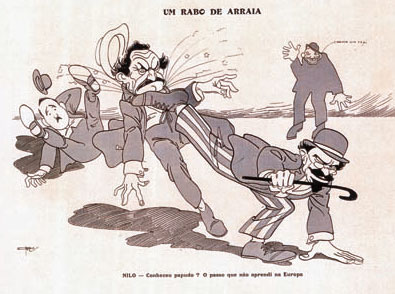
https://www.youtube.com/watch?v=7miUrDc5VWo
Note: I call the kick by its modern name - Meia lua de compasso - to avoid confusion with other techniques.
MLDC is one of the symbols of capoeira. However, in modern capoeira, it is mostly done wrong; this article as about the real, original MLDC as used in old Carioca.
-

(Rabo de arraia on a historic carricature; note the lifted head and arched body; and the effect of throwing the opponent by hiting under his chin. However, there is a mistake in the picture: both hands must be on the ground).
In my LightLegs article, I have already shown that modern MLDC is a bad kick; as it is not done with LightLegs, and in some instances (using one hand on the ground only) it even cannot be done with LightLegs.
Contrary to that the 'proper' MLDC, used in old Bahian Capoeira, was done with LightLegs, and thus with both hands on the ground.
-
However, the situation is even more complex. Even the old Bahian MLDC with LightLegs is not the true, most powerful MLDC.
The true MLDC - as done in old Carioca - was not only done using LightLegs; but using LightLegs and Seduction1 modificators, together.
This changes the kick dramatically.
First, physically: The kicking leg is semi bent(arched) as it kicks; which makes the kick more powerful and not likely to damage the knee of the kicking leg. Also, the fighter's head is raised up and he is looking over his shoulder.
Second, energeticaly: This MLDC is a high-energy point, done with "Haaa!" vocalization.
Finally, as to its effect. If you do the true MLDC, with LightLegs+Seduction1, with vocalization, it works as other acrokicks: When it hits the opponent, it applies a nerve strangle, then slams him to the ground.
Also, it has the 'LightLegs effect' - if the opponent tries to block the kick with his hands, he causes his own nerve disruption.
Neither of these is present in the Bahian MLDC.
-
The hidden nerve disruptor
Additionally, the true MLDC has a hidden nerve disruption that makes it even more powerful: When reaching down with your arms, rub opponent's front thigh with your buttocks. This creates a nerve disruption; so he cannot evade the follow-up. Immediately afterwards, your kicking leg hits hard under his chin, creating a nerve strangle and smashing him on the ground (and probably also knocking him out).
(Note that this is very similar to properly done Pantana).
Thus the true MLDC is not a kick; but a high-impact throwing technique.
--
Note that MLDC, done this way (with the thigh-rubbing nerve disruption and hitting opponent's chin) is a lot more upright (handstand-like) than you are used to seeing in modern capoeira (and Bahian capoeira in general). It is also done a lot closer, of course.
--
Aside from hitting opponent's chin, you can also hit his flank or chest/solar plexus/belly (front of his torso) with the same effect.
--
Note that again, true MLDC must be done with both hands on the floor; not one or zero.
--
True MLDC is done as a counter; from the rear position of Peneiracao (or ginga).
MLDC cannot be used from Negaca; for that, you need Flying 41 or 41.
--
MLDC was called 'Rabo de arraia' in Plácido de Abreu(1886) and in Moraes Filhos(1901).
--
Note that doing MLDC with Seduction1 modificator (as described here) gives it one more property: The body is arched as you kick (a lot more than in normal MLDC); this makes the energy transfer much more efficient. Consider:
If you kick normal full power MLDC into a heavy bag (and I mean a heavy one), the counterforce will probably mess up your knee badly (been there, done that). Not so in this true Carioca MLDC; here, the energy flows smoothly down your leg and body; so you can kick full power even into a heavy bag!
This is the real stuff; not the modern simulacra!
This Web Page was Built with PageBreeze Free HTML Editor